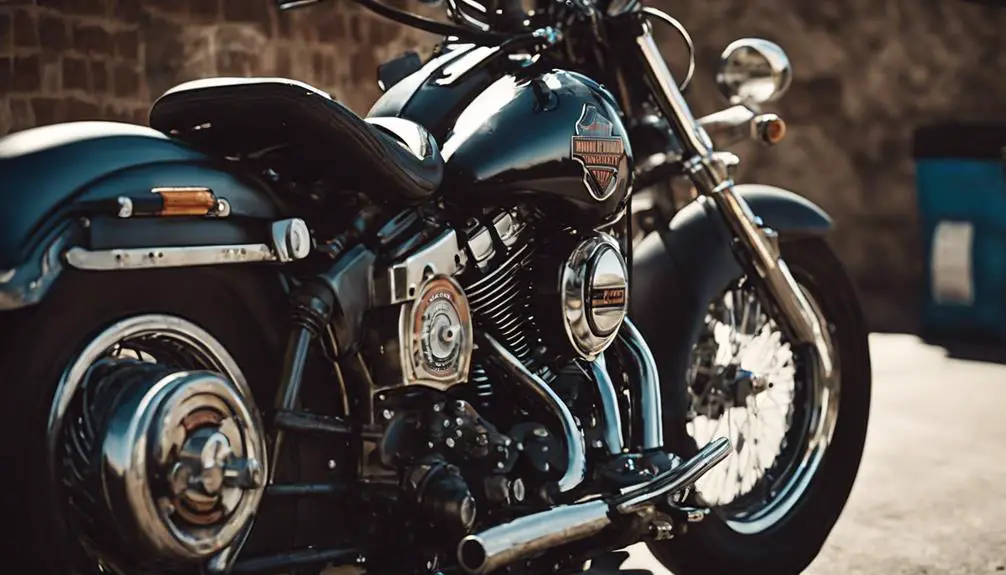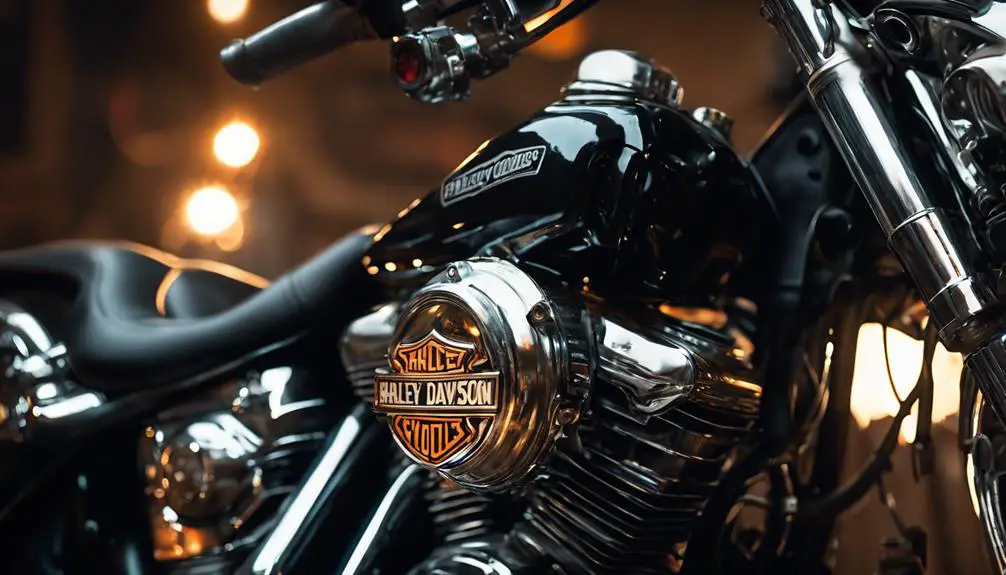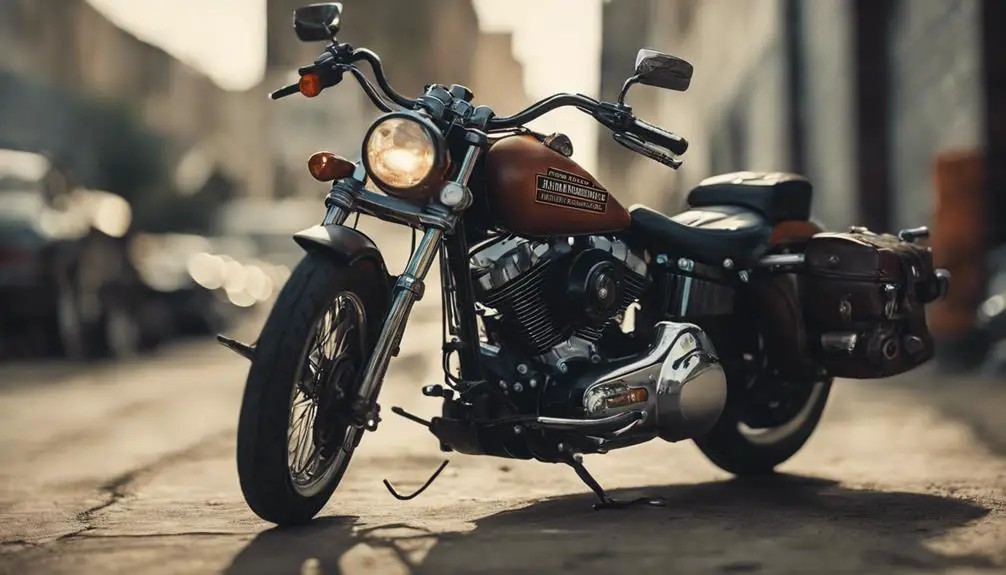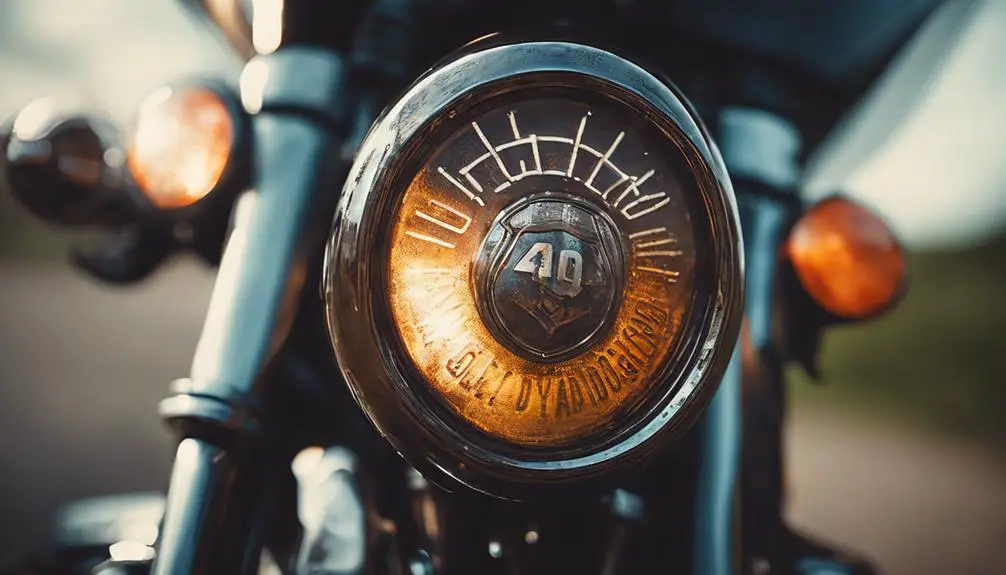Have you ever wondered if there’s a straightforward method to determine the ideal oil change interval for your Harley-Davidson? Perhaps you’ve heard various opinions on the matter but haven’t quite found the definitive answer yet. Well, what if there was a simple trick that could provide you with the perfect schedule tailored specifically to your motorcycle’s requirements?
The recommended oil change interval for Harley-Davidson is every 5,000 miles or six months, whichever comes first, for optimal engine health.
Stay tuned to uncover this insightful approach that could revolutionize how you maintain your Harley’s engine health.
Key Takeaways
- Determine oil type and quality for interval accuracy.
- Consider manufacturer’s recommendations for ideal timing.
- Tailor intervals based on riding conditions and habits.
- Regularly monitor oil level and quality for adjustments.
- Use oil analysis for personalized oil change schedule.
Importance of Regular Oil Changes
Regular oil changes are essential to guarantee peak engine performance and longevity in your Harley-Davidson motorcycle. Your engine relies on oil to lubricate internal components, preventing wear caused by overheating.
Consult your owner’s manual to determine the type of oil your specific Harley model requires – whether synthetic, semi-synthetic, or mineral oil – each offering different lifespans.
It’s recommended to change the first oil after 1000 miles to ensure peak engine health and performance.
Following a consistent oil change interval based on the type of oil used in your motorcycle is key to maintaining engine efficiency and longevity.
By adhering to Harley’s guidelines for oil changes, you’re taking a proactive step in preserving your engine’s health and ensuring it operates at its best.
Understanding Your Harley-Davidson’s Engine
Your Harley-Davidson’s engine relies on proper lubrication to function at its best, ensuring all internal components work together seamlessly.
Understanding the importance of engine oil and adhering to the manufacturer’s recommended maintenance schedule are essential for prolonging the life of your motorcycle.
Engine Oil Importance
Adequate engine oil is essential for maintaining peak performance and longevity in your Harley-Davidson motorcycle. The oil in your bike serves a critical role in lubricating internal components, reducing friction, and preventing overheating. Different Harley models require specific types of engine oil, such as synthetic, semi-synthetic, and mineral oils.
Regular oil changes are vital to prevent engine parts from wearing out prematurely due to the heat and friction generated during operation. Synthetic oils, commonly used in Harley-Davidson motorcycles, typically need to be changed every 7000 to 10000 miles. On the other hand, semi-synthetic oils should be replaced after 5000 to 6000 miles to ensure peak engine performance.
Harley recommends changing the first oil at 1000 miles and adhering to the maintenance schedule thereafter. By following these guidelines, you can ensure that your Harley-Davidson engine remains in top condition, delivering the power and reliability you expect.
Maintenance Schedule Timing
To guarantee peak engine performance and longevity for your Harley-Davidson motorcycle, understanding the maintenance schedule timing specific to your model is essential. Engine efficiency, long-term maintenance, and overall engine performance rely heavily on adhering to the recommended oil change intervals.
For newer Harley models using synthetic oils, changing the oil between 7000 and 10000 miles is vital to ensure top-notch engine health. Semi-synthetic oils should be replaced after 5000 to 6000 miles, while older models utilizing mineral oils require more frequent changes, typically every 2000 miles.
Factors Influencing Oil Change Frequency

When considering the factors that influence your Harley-Davidson’s oil change frequency, it’s important to assess the type and quality of oil you use. Synthetic oils generally last longer than mineral oils, impacting how often you need to change the oil.
Additionally, factors like riding conditions and adhering to the manufacturer’s recommendations play a significant role in determining the ideal oil change interval for your motorcycle.
Oil Type and Quality
When determining the best oil change frequency for your Harley-Davidson motorcycle, the type and quality of oil utilized are vital factors to take into account. Conducting an oil viscosity analysis can help determine the appropriate interval for your specific oil type.
Synthetic oils, known for their durability and performance, generally allow for longer intervals between changes, ranging from 7000 to 10000 miles. In contrast, semi-synthetic oils require more frequent changes, typically around 5000 to 6000 miles. Mineral oils, with their shorter lifespan, necessitate changes every 2000 miles to maintain engine health.
Despite common oil change myths, such as the belief that all oils last the same duration, understanding the differences between synthetic and mineral oils is crucial. The quality and type of oil you choose play a critical role in ensuring your Harley-Davidson motorcycle’s engine receives the proper lubrication and protection it needs for top performance.
Riding Conditions Impact
Riding conditions greatly influence the frequency at which you should change the oil in your Harley-Davidson motorcycle. Here are three key factors to keep in mind:
- Weather Impact on Oil Degradation:
Extreme temperatures, whether hot summers or cold winters, can accelerate oil degradation. In hotter climates, oil may break down faster, losing its lubricating properties sooner and requiring more frequent changes to maintain engine health.
- Riding Style and Oil Lifespan:
Your riding style plays an important role in determining oil change intervals. Aggressive riding, high RPMs, and frequent acceleration can put more stress on the engine, leading to quicker oil degradation. Conversely, steady, consistent riding at moderate speeds can extend the lifespan of your oil.
- Load Weight and Oil Maintenance:
Heavy loads, towing, or riding in dusty environments can contaminate the oil faster, reducing its effectiveness. Regularly inspecting the oil quality and changing it as needed based on these conditions is essential for optimal engine performance and longevity.
Manufacturer’s Recommendations
Factors influencing the frequency of oil changes for your Harley-Davidson motorcycle include the engine type, riding conditions, and the type of oil utilized. Following the manufacturer’s recommendations is essential for maintaining peak engine performance and longevity.
Different types of oils have varying lifespans, with synthetic oils lasting longer compared to semi-synthetic and mineral oils. Regular oil changes not only guarantee proper maintenance habits but also contribute to engine longevity by providing excellent lubrication and protection against wear and tear.
Step-by-Step Guide to Determining Interval
To determine the perfect oil change interval for your Harley-Davidson motorcycle, begin by identifying the type of engine oil used. Here is a step-by-step guide to help you establish the ideal interval:
- Oil Analysis Benefits: Consider conducting oil analysis to understand the condition of your oil and determine if it can last longer than the standard intervals.
- Seasonal Variations Impact: Take into account seasonal changes in temperature and riding conditions. Hotter weather may require more frequent oil changes to maintain peak performance.
- DIY vs Professional Servicing: Decide whether you’ll change the oil yourself or take your Harley-Davidson to a professional. DIY servicing allows for more frequent checks and customization, while professional servicing ensures expert care and adherence to manufacturer guidelines.
Monitoring Oil Quality and Performance

Regularly evaluating the quality and performance of your Harley-Davidson’s oil is essential for maintaining peak engine function and longevity. Monitoring techniques involve observing oil color and consistency. Fresh oil appears blue or brown, while degraded oil turns black and thin, signaling the need for a change.
Contaminated oil loses its consistency and may become gritty, negatively impacting engine performance. Additionally, a reduced oil level could indicate oil consumption due to degradation or leaks, emphasizing the importance of monitoring oil quality closely. If uncertainty exists about the last oil change, immediate replacement is necessary to uphold engine efficiency.
Recommended Oil Change Tools and Products
When preparing for an oil change on your Harley-Davidson motorcycle, make sure you have essential tools like a drain pan, socket set, oil filter wrench, torque wrench, and a funnel at your disposal.
Here are some key considerations for your oil change:
- Oil Filter Compatibility: Verify you use the correct oil filter for your Harley model to guarantee proper filtration and engine protection during oil changes. Look for filters that are specifically designed for your bike’s make and model.
- Synthetic vs Mineral Oil: When selecting oil products for your Harley-Davidson, consider the benefits of synthetic oils over mineral oils. Synthetic oils offer superior lubrication properties, improved engine protection, and better performance in extreme temperatures compared to mineral oils.
- Screamin’ Eagle vs Aftermarket Oils: Evaluate the performance of Harley-Davidson-approved oils like Screamin’ Eagle SYN3 against aftermarket options. Screamin’ Eagle oils are known for providing excellent lubrication and heat protection, especially beneficial for high-performance engines.
Compare these with reputable aftermarket brands like Mobil 1, Amsoil, and Bel-Ray to find the best fit for your motorcycle’s needs.
Common Mistakes to Avoid

Neglecting to adhere to Harley-Davidson’s recommended oil change intervals can have detrimental effects on your motorcycle’s engine performance and longevity.
When it comes to DIY maintenance, one common mistake to avoid is assuming that all oils are the same. Using the wrong type of oil can impact the best oil change interval for your Harley. Additionally, falling for oil change misconceptions, such as believing that oil color is the only indicator for a change, can lead to engine damage.
Another error to steer clear of is taking into account your riding habits and environmental conditions when determining the right time for an oil change. Different riding conditions may require adjustments to the oil change interval to maintain top engine performance.
Lastly, failing to follow a regular maintenance schedule can affect the efficiency and longevity of your Harley’s engine. By being mindful of these common mistakes, you can ensure that your motorcycle operates at its best.
Adjusting Interval for Riding Conditions
Taking your riding conditions into account is crucial when determining the best oil change interval for your Harley-Davidson. To guarantee peak engine performance and longevity, follow these key steps:
- Riding habits assessment: Evaluate how you typically ride your Harley-Davidson. Do you frequently encounter stop-and-go traffic, or do you mainly enjoy long highway rides? Understanding your riding habits will help tailor the oil change interval to your specific needs.
- Environmental factors consideration: Consider the environmental conditions in which you ride. Extreme temperatures, high humidity, and dusty environments can all impact your motorcycle’s engine and the oil’s effectiveness. Adjust your oil change interval accordingly based on these factors.
- Engine performance evaluation: Regularly assess your Harley-Davidson’s engine performance. If you notice any changes in how your motorcycle runs, such as decreased power or unusual sounds, it may be time to adjust your oil change interval to maintain peak performance.
FAQs on Harley-Davidson Oil Changes

For best maintenance of your Harley-Davidson motorcycle, it’s essential to address common questions regarding oil changes. Understanding the benefits of regular oil changes is vital for peak engine performance.
Harley-Davidson recommends changing the first oil after 1000 miles to guarantee proper lubrication and protection. Synthetic oils commonly used in Harley bikes should be changed between 7000 and 10000 miles, while semi-synthetic oils require more frequent changes at 5000 to 6000 miles.
Mineral oils, found in some models, need more frequent changes at least every 2000 miles to prevent engine damage. Regularly monitoring the oil level and quality is key to determining the appropriate oil change interval for your specific Harley-Davidson motorcycle.
Following these maintenance tips will help extend the life of your engine and ensure smooth performance on the road.
Conclusion
To wrap up, by following these steps, you can easily pinpoint the ideal oil change interval for your Harley-Davidson.
Keep in mind, ‘the proof is in the pudding’ – regularly monitoring oil quality and performance will guarantee your motorcycle’s engine stays in top condition.
With the right tools, products, and a tailored schedule, you can maintain peak performance and longevity for your beloved Harley.
Ride on with confidence knowing your engine is well taken care of!

